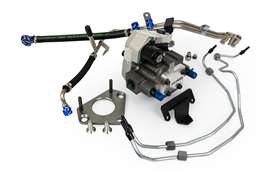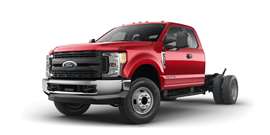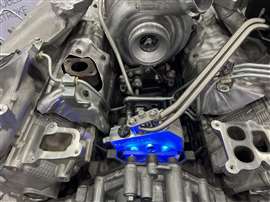This fuel pump protects diesel engines
31 July 2023
Fuel pump kit provides solution, represents new Stanadyne strategy
The National Farm Machinery Show was a surprising place to introduce a fuel pump conversion kit designed for trucks, what with all the new tractors, manure lagoon pumps and grain carts on display at the expo center. For S&S Diesel Motorsport, however, the annual agricultural equipment event in Louisville, Ky., was an obvious and ultimately effective choice.
 Installed with OEM-grade braided hose and steel fuel lines, the kit gives owners plug-and-play replacement that performs like original equipment. (Photo: Stanadyne)
Installed with OEM-grade braided hose and steel fuel lines, the kit gives owners plug-and-play replacement that performs like original equipment. (Photo: Stanadyne)
“The amount of website traffic and the buzz this product generated was overwhelming,” said Luke Langellier, co-owner of S&S Diesel Motorsport in Seymour, Ind. “It was just huge. We’d never seen a release get this much traffic before. This product is perfect, too, because it’s something that they’ve wanted for a long time.”
Over the course of 18 months, S&S Diesel worked with PurePower Technologies, the aftermarket division of fuel system specialist Stanadyne, to develop a component that could solve a common problem with the CP4 fuel pump used in the 6.7 L Power Stroke diesel engine. The powerplant is popular in Ford Super Duty trucks.
“When the guys at S&S said they wanted to do the big reveal at a farm show, I didn’t quite understand why we’d show a truck engine product there,” said Ed Flanagan, director of Global Business Development and Sales, Stanadyne LLC, Jacksonville, N.C. “I asked them to walk me though their thinking, and they said, ‘when you walk out in the parking lot at a farm show, what do you see? Eight out of 10 vehicles out there are pickup trucks. And six out of the eight are Super Duty trucks.’ Turns out it was brilliant idea.”
According to S&S Diesel, the CP4 fuel pump likes to fail without warning, which creates a sudden power loss and can send debris into the engine’s high-pressure fuel system. It has long offered a solution that essentially prevents shrapnel from traveling downstream, but there were no direct replacements for the pump itself.
“This particular application challenge has been one that has posed significant and troublesome situations for vehicle owners for quite some time,” said PurePower Technologies Managing Director Jeff Blake. “The pump conversion can save truck owners $10,000 to $15,000 in repairs — in addition to providing peace of mind by avoiding potential vehicle downtime.”
A Stanadyne company since 2019, PurePower has produced more than 30 million precision diesel fuel injectors since 1999. The latter company tapped into the group’s global fuel systems expertise to develop a conversion kit based on the existing two-piston DCR (Diesel Common Rail) fuel pump. The kit is emissions compliant, and fits 2011-’19 Ford F-250 through F-750 diesel trucks. The company said it plans to ensure future compatibility on 2020 and later models.
Fuel system expertise
Designed for Super Duty truck-based applications used by consumers as well commercial operators for jobs that range from construction crew transport to last-mile delivery to ambulances, the genesis for the fuel pump kit comes from motorsports.
“My hobby is diesel truck drag racing,” said Ryan Reiser, product development engineer, PurePower Technologies, Columbia, S.C., “and I’ve been building a truck that was finally ready to race. We tested it a couple of times at the shop and then went to the drag strip. We weren’t 60 ft. off the starting line and the truck started dying. At the end of the track the motor completely locked up — and my happy day went away fast. When we got it back to the shop, we found the CP4 pump was locked up and it actually sent metal shavings through all the injectors and trashed fuel system.”
 The Ford Super Duty truck, such as this 2017 F-350 chassis cab, has been employed in a wide range of commercial applications, including ambulances. (Photo: Ford Motor Company)
The Ford Super Duty truck, such as this 2017 F-350 chassis cab, has been employed in a wide range of commercial applications, including ambulances. (Photo: Ford Motor Company)
According to Reiser, that fateful day was Oct. 15, 2021. He knew about Stanadyne’s DCR pump that was already being used in on-highway vehicles throughout Asia, pulled one off the shelf, and following a little modification got it working with his diesel engine. He knew he had found a solution for his Ford dragster, and one the market needed. He then called S&S Motorsports to see if they wanted to help take the concept to the next level. By June 2022, the team had outfitted a truck with the new pump design and started driving it.
S&S Diesel Motorsport has amassed years of diesel fuel injection and engine development and testing experience that is typically used for customers building machines for competition and CARB-compliant street use.
“What was valuable about this relationship is that the majority of us at Stanadyne have the mindset of an OEM, and then you have the aftermarket guys at S&S who are used to thinking outside of the box,” said Flanagan. “They identified things that we wouldn’t have thought of, and with their help we took a solution that was great and made it even better in less than 18 months. That’s warp speed, but along the way we were still looking for ways to make it go faster because there is such a demand for it.”
Starting with a proven Stanadyne DCR fuel pump design, engineers at S&S and PurePower developed a variant that matches the CP4 output curve and does not require calibration changes. PurePower said the new pump is a compact, modular design for easy integration. It puts out minimal hydraulic and acoustical noise, has fast response times, and is biofuel and low-lubricity fuel compatible. It uses a patented eccentric drive pumping technology with pressure-lubricated cam and bushings for increased performance, efficiency and durability. It also comes equipped with Stanadyne’s new inlet metering valve (IMV) designed to extend pump life. The IMV uses corrosion-resistant components and proprietary features to prevent large debris from entering the valve, providing robustness in harsh environmental conditions.
The pump can provide up to 2200 bar of pressure with maximum fuel delivery of 1250 mm3 per revolution. Installed with OEM-grade braided hose and steel fuel lines, the companies said the kit gives owners plug-and-play replacement that performs like original equipment.
S&S ultimately put the pump through an extensive road-test program in 20 different applications throughout the U.S. It is available now.
 Starting with a Stanadyne design, engineers at S&S and PurePower developed a fuel pump variant that matches the 6.7 L engine’s CP4 output curve and does not require calibration changes. (Photo: Stanadyne)
Starting with a Stanadyne design, engineers at S&S and PurePower developed a fuel pump variant that matches the 6.7 L engine’s CP4 output curve and does not require calibration changes. (Photo: Stanadyne)
Major changes afoot
For Stanadyne, Flanagan said the project also highlights a significant change in the way the company will approach the commercial and industrial vehicle market going forward. He said the quick turn-around times that are part of PurePower’s work in the aftermarket space can help fill in for the long product development times required for new engine projects at the OEM level — while also helping the company develop and test new component designs.
“We’ve seen a paradigm shift in how we do business,” he said. “About a year and a half ago, we changed gears. We now use the performance aftermarket industry to drive new technology. If this pump kit was an OEM project, we’d still be in development, and it would still be top secret. In the aftermarket you’re anywhere from 12 to 18 months from concept to market, and you have a lot more flexibility in terms of sales.”
It’s not just the aftermarket industry that can’t wait for a solution. “We’ve seen the off-highway folks especially wanting projects turned around more quickly as they work with alternative fuels. We’ve adapted accordingly.
“A lot of our global customers, such as engine and power gen manufacturers, are looking at alternative fuels like hydrogen, methanol and natural gas. With our core competencies on the spark-ignition technology side through fuel pumps and injectors we can support hydrogen and natural gas and on the diesel side we can fully support alcohol and methanol with very little modification. And now we can bring this to development faster than ever.”
This article originally ran in the June 2023 issue of Diesel Progress.
CONECTAR-SE COM A EQUIPE





